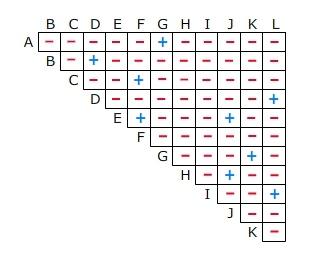Question
The biological species concept defines a species as a group of populations whose members have the potential to interbreed in nature and produce viable, fertile
The biological species concept defines a species as a group of populations whose members have the potential to interbreed in nature and produce viable, fertile offspring. This means that all members of these populations can contribute to a common gene pool. These populations belong to the same species. Genes are transferred between these populations through both direct and indirect gene flow.
Biologists used genetic techniques to look for gene flow in 12 wild populations of mice. The populations (designated A through L) were located along a 210-km transect line.

Some hints if you need them (hints open in new frame):
Hint 1: how to approach the problem
Hint 2: how to read this data grid
Hint 3: how to find species
The researchers found evidence of gene flow between some, but not all, pairs of populations. In the grid below, a "+" indicates a pair of populations in which direct gene flow was detected, and a "–" indicates a pair that showed no evidence of direct gene flow. For help reading this grid, see Hint 2.

The researchers discovered that the 12 populations could be organized into 3 distinct species. Populations A, B, and C each belong to a different species. Use the data in the grid to sort each population to the species to which it belongs.
Species 1 includes species A
Species 2 includes species B
Species 3 includes species C
Population D is species
[ Choose ] 3 (which includes species C) 2 (which includes species B) 1 (which includes species A)
Population E is species
[ Choose ] 3 (which includes species C) 2 (which includes species B) 1 (which includes species A)
Population F is species
[ Choose ] 3 (which includes species C) 2 (which includes species B) 1 (which includes species A)
Population G is species
[ Choose ] 3 (which includes species C) 2 (which includes species B) 1 (which includes species A)
Population H is species
[ Choose ] 3 (which includes species C) 2 (which includes species B) 1 (which includes species A)
Population I is species
[ Choose ] 3 (which includes species C) 2 (which includes species B) 1 (which includes species A)
Population J is species
[ Choose ] 3 (which includes species C) 2 (which includes species B) 1 (which includes species A)
Population K is species
[ Choose ] 3 (which includes species C) 2 (which includes species B) 1 (which includes species A)
Population L is species
D. E F G J. K. L 50 km
Step by Step Solution
3.48 Rating (165 Votes )
There are 3 Steps involved in it
Step: 1
Answer Population D is species 3 which includes species C The grid shows that Population D was found to have direct gene flow with both Population C a...
Get Instant Access to Expert-Tailored Solutions
See step-by-step solutions with expert insights and AI powered tools for academic success
Step: 2

Step: 3

Ace Your Homework with AI
Get the answers you need in no time with our AI-driven, step-by-step assistance
Get Started


